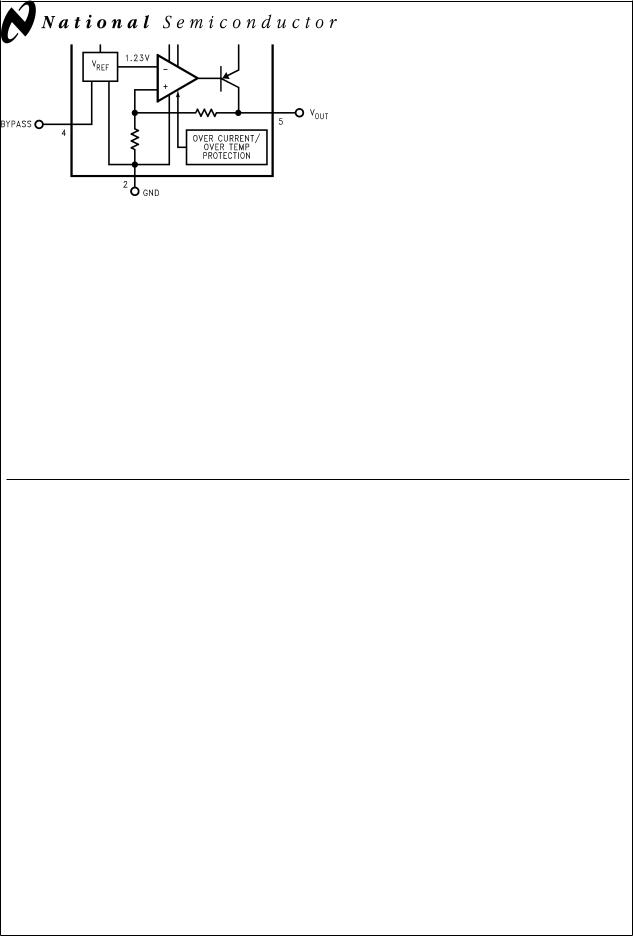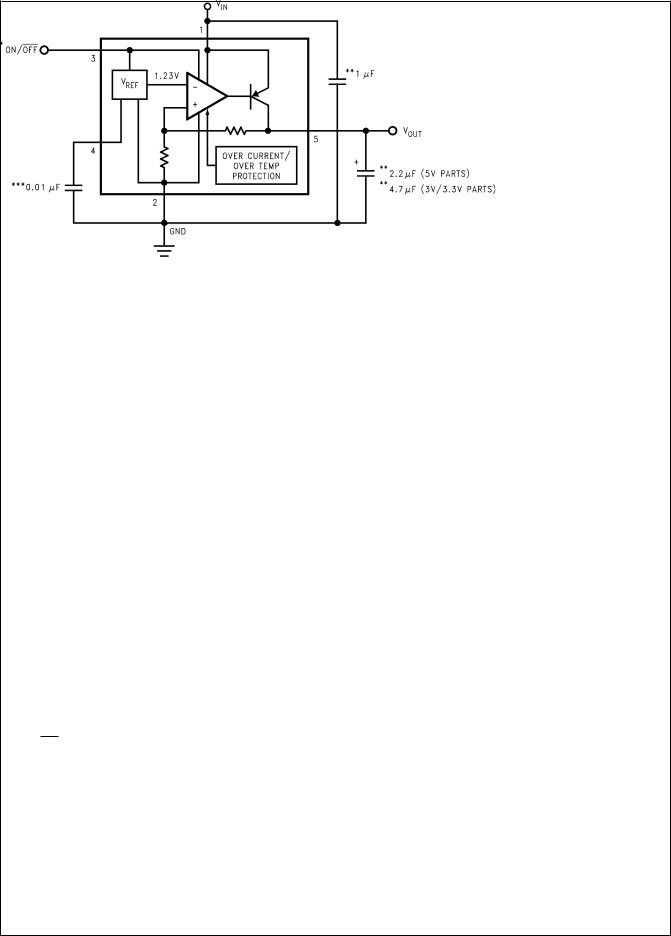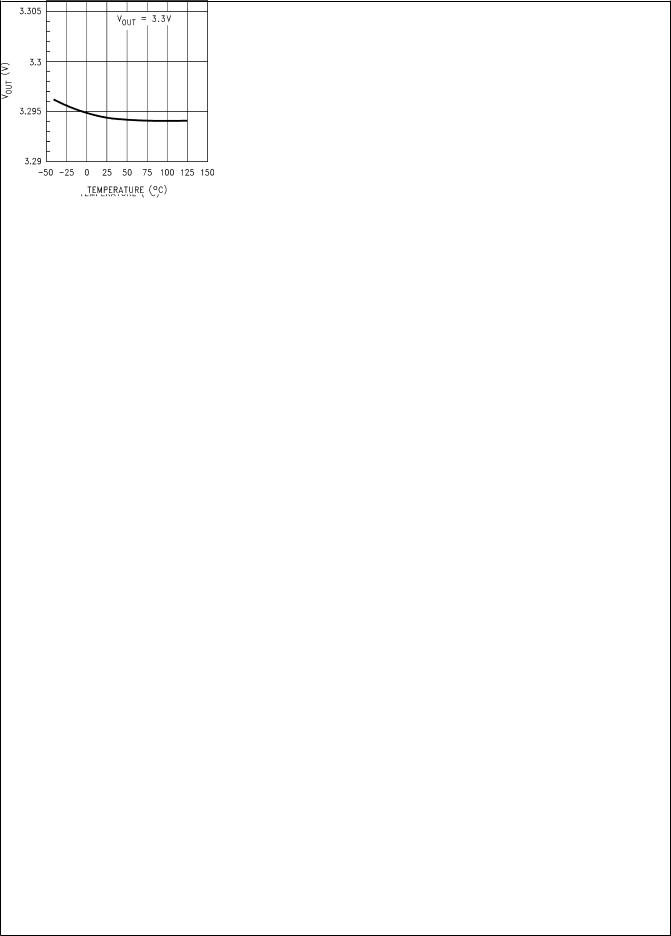NSC LP2982AIM5-2.5, LP2982AIBPX-2.8, LP2982AIBP-3.0, LP2982AIBP-2.8, LP2982IM5X-5.0 Datasheet
...
March 2000
LP2982
Micropower 50 mA Ultra Low-Dropout Regulator
General Description
The LP2982 is a 50 mA, fixed-output voltage regulator designed to provide ultra low dropout and lower noise in battery powered applications.
Using an optimized VIP™ (Vertically Integrated PNP) process, the LP2982 delivers unequaled performance in all specifications critical to battery-powered designs:
Dropout Voltage: Typically 120 mV @ 50 mA load, and 7 mV @ 1 mA load.
Ground Pin Current: Typically 375 µA @ 50 mA load, and 80 µA @ 1 mA load.
Sleep Mode: Less than 1 µA quiescent current when on/off pin is pulled low.
Smallest Possible Size: SOT-23 and micro SMD packages use absolute minimum board space.
Precision Output: 1.0% tolerance output voltages available (A grade).
Low Noise: By adding an external bypass capacitor, output noise can be reduced to 30 µV (typical).
Ten output voltage versions, from 2.5V to 5.0V, are available as standard products.
Features
nUltra low dropout voltage
nGuaranteed 50 mA output current
nTypical dropout voltage 180 mV @ 80 mA
nSmallest possible size (SOT-23, micro SMD package)
nRequires minimum external components
n< 1 µA quiescent current when shutdown
nLow ground pin current at all loads
nOutput voltage accuracy 1.0% (A Grade)
nHigh peak current capability (150 mA typical)
nWide supply voltage range (16V max)
nLow ZOUT 0.3Ω typical (10 Hz to 1 MHz)
nOvertemperature/overcurrent protection
n−40ÊC to +125ÊC junction temperature range
nCustom voltages available
Applications
nCellular Phone
nPalmtop/Laptop Computer
nPersonal Digital Assistant (PDA)
nCamcorder, Personal Stereo, Camera
Block Diagram
DS012679-1
VIP™ is a trademark of National Semiconductor Corporation.
Regulator Dropout-Low Ultra mA 50 Micropower LP2982
© 2000 National Semiconductor Corporation |
DS012679 |
www.national.com |

LP2982
Connection Diagrams
5-Lead Small Outline Package (M5)
DS012679-3
Top View
See NS Package Number MF05A For ordering information see Table 1
Basic Application Circuit
micro SMD, 5 Bump Package (BPA05)
DS012679-55
Bottom View
See NS Package Number BPA05
DS012679-2
*ON/OFF input must be actively terminated. Tie to VIN if this function is not to be used.
**Minimum capacitance is shown to insure stability over full load current range. More capacitance provides superior dynamic performance (see Application Hints).
***See Application Hints.
www.national.com |
2 |

Ordering Information
TABLE 1. Package Marking and Ordering Information
Output Voltage |
|
|
Package |
|
(V) |
Grade |
Order Information |
Marking |
Supplied as: |
|
|
|
|
|
5-Lead Small Outline Package (M5) |
|
|
|
|
|
|
|
|
|
2.5 |
A |
LP2982AIM5X-2.5 |
L58A |
3000 Units on Tape and Reel |
|
|
|
|
|
2.5 |
A |
LP2982AIM5-2.5 |
L58A |
1000 Units on Tape and Reel |
|
|
|
|
|
2.5 |
STD |
LP2982IM5X-2.5 |
L58B |
3000 Units on Tape and Reel |
|
|
|
|
|
2.5 |
STD |
LP2982IM5-2.5 |
L58B |
1000Units on Tape and Reel |
|
|
|
|
|
2.6 |
A |
LP2982AIM5X-2.6 |
LBYA |
3000 Units on Tape and Reel |
|
|
|
|
|
2.6 |
A |
LP2982AIM5-2.6 |
LBYA |
1000 Units on Tape and Reel |
|
|
|
|
|
2.6 |
STD |
LP2982IM5X-2.6 |
LBYB |
3000 Units on Tape and Reel |
|
|
|
|
|
2.6 |
STD |
LP2982IM5-2.6 |
LBYB |
1000Units on Tape and Reel |
|
|
|
|
|
2.8 |
A |
LP2982AIM5X-2.8 |
L60A |
3000 Units on Tape and Reel |
|
|
|
|
|
2.8 |
A |
LP2982AIM5-2.8 |
L60A |
1000 Units on Tape and Reel |
|
|
|
|
|
2.8 |
STD |
LP2982IM5X-2.8 |
L60B |
3000 Units on Tape and Reel |
|
|
|
|
|
2.8 |
STD |
LP2982IM5-2.8 |
L60B |
1000 Units on Tape and Reel |
|
|
|
|
|
3.0 |
A |
LP2982AIM5X-3.0 |
L20A |
3000 Units on Tape and Reel |
|
|
|
|
|
3.0 |
A |
LP2982AIM5-3.0 |
L20A |
1000 Units on Tape and Reel |
|
|
|
|
|
3.0 |
STD |
LP2982IM5X-3.0 |
L20B |
3000 Units on Tape and Reel |
|
|
|
|
|
3.0 |
STD |
LP2982IM5-3.0 |
L20B |
1000 Units on Tape and Reel |
|
|
|
|
|
3.3 |
A |
LP2982AIM5X-3.3 |
L19A |
3000 Units on Tape and Reel |
|
|
|
|
|
3.3 |
A |
LP2982AIM5-3.3 |
L19A |
1000 Units on Tape and Reel |
|
|
|
|
|
3.3 |
STD |
LP2982IM5X-3.3 |
L19B |
3000 Units on Tape and Reel |
|
|
|
|
|
3.3 |
STD |
LP2982IM5-3.3 |
L19B |
1000 Units on Tape and Reel |
|
|
|
|
|
3.6 |
A |
LP2982AIM5X-3.6 |
L0BA |
3000 Units on Tape and Reel |
|
|
|
|
|
3.6 |
A |
LP2982AIM5-3.6 |
L0BA |
1000 Units on Tape and Reel |
|
|
|
|
|
3.6 |
STD |
LP2982IM5X-3.6 |
L0BB |
3000 Units on Tape and Reel |
|
|
|
|
|
3.6 |
STD |
LP2982IM5-3.6 |
L0BB |
1000 Units on Tape and Reel |
|
|
|
|
|
3.8 |
A |
LP2982AIM5X-3.8 |
L76A |
3000 Units on Tape and Reel |
|
|
|
|
|
3.8 |
A |
LP2982AIM5-3.8 |
L76A |
1000 Units on Tape and Reel |
|
|
|
|
|
3.8 |
STD |
LP2982IM5X-3.8 |
L76B |
3000 Units on Tape and Reel |
|
|
|
|
|
3.8 |
STD |
LP2982IM5-3.8 |
L76B |
1000 Units on Tape and Reel |
|
|
|
|
|
4.0 |
A |
LP2982AIM5X-4.0 |
L29A |
3000 Units on Tape and Reel |
|
|
|
|
|
4.0 |
A |
LP2982AIM5-4.0 |
L29A |
1000 Units on Tape and Reel |
|
|
|
|
|
4.0 |
STD |
LP2982IM5X-4.0 |
L29B |
3000 Units on Tape and Reel |
|
|
|
|
|
4.0 |
STD |
LP2982IM5-4.0 |
L29B |
1000 Units on Tape and Reel |
|
|
|
|
|
4.5 |
A |
LP2982AIM5X-4.5 |
LA8A |
3000 Units on Tape and Reel |
|
|
|
|
|
4.5 |
A |
LP2982AIM5-4.5 |
LA8A |
1000 Units on Tape and Reel |
|
|
|
|
|
4.5 |
STD |
LP2982IM5X-4.5 |
LA8B |
3000 Units on Tape and Reel |
|
|
|
|
|
4.5 |
STD |
LP2982IM5-4.5 |
LA8B |
1000 Units on Tape and Reel |
|
|
|
|
|
4.7 |
A |
LP2982AIM5X-4.7 |
L0HA |
3000 Units on Tape and Reel |
|
|
|
|
|
4.7 |
A |
LP2982AIM5-4.7 |
L0HA |
1000 Units on Tape and Reel |
|
|
|
|
|
4.7 |
STD |
LP2982IM5X-4.7 |
L0HB |
3000 Units on Tape and Reel |
|
|
|
|
|
4.7 |
STD |
LP2982IM5-4.7 |
L0HB |
1000 Units on Tape and Reel |
|
|
|
|
|
5.0 |
A |
LP2982AIM5X-5.0 |
L18A |
3000 Units on Tape and Reel |
|
|
|
|
|
5.0 |
A |
LP2982AIM5-5.0 |
L18A |
1000 Units on Tape and Reel |
|
|
|
|
|
5.0 |
STD |
LP2982IM5X-5.0 |
L18B |
3000 Units on Tape and Reel |
|
|
|
|
|
5.0 |
STD |
LP2982IM5-5.0 |
L18B |
1000 Units on Tape and Reel |
|
|
|
|
|
5.3 |
A |
LP2982AIM5X-5.3 |
LBZA |
3000 Units on Tape and Reel |
|
|
|
|
|
LP2982
3 |
www.national.com |

LP2982
Ordering Information (Continued)
TABLE 1. Package Marking and Ordering Information (Continued)
Output Voltage |
|
|
Package |
|
(V) |
Grade |
Order Information |
Marking |
Supplied as: |
|
|
|
|
|
5-Lead Small Outline Package (M5) |
|
|
|
|
|
|
|
|
|
5.3 |
A |
LP2982AIM5-5.3 |
LBZA |
1000 Units on Tape and Reel |
|
|
|
|
|
5.3 |
STD |
LP2982IM5X-5.3 |
LBZB |
3000 Units on Tape and Reel |
|
|
|
|
|
5.3 |
STD |
LP2982IM5-5.3 |
LBZB |
1000 Units on Tape and Reel |
|
|
|
|
|
micro SMD, 5 Bump Package (BPA05) |
|
|
||
|
|
|
|
|
2.8 |
A |
LP2982AIBP-2.8 |
|
250 Units on Tape and Reel |
|
|
|
|
|
2.8 |
A |
LP2982AIBPX-2.8 |
|
3000 Units on Tape and Reel |
|
|
|
|
|
2.8 |
STD |
LP2982IBP-2.8 |
|
250 Units on Tape and Reel |
|
|
|
|
|
2.8 |
STD |
LP2982IBPX-2.8 |
|
3000 Units on Tape and Reel |
|
|
|
|
|
3.0 |
A |
LP2982AIBP-3.0 |
|
250 Units on Tape and Reel |
|
|
|
|
|
3.0 |
A |
LP2982AIBPX-3.0 |
|
3000 Units on Tape and Reel |
|
|
|
|
|
3.0 |
STD |
LP2982IBP-3.0 |
|
250 Units on Tape and Reel |
|
|
|
|
|
3.0 |
STD |
LP2982IBPX-3.0 |
|
3000 Units on Tape and Reel |
|
|
|
|
|
www.national.com |
4 |

Absolute Maximum Ratings (Note 1)
If Military/Aerospace specified devices are required, please contact the National Semiconductor Sales Office/ Distributors for availability and specifications.
Storage Temperature Range |
−65ÊC to +150ÊC |
Operating Junction Temperature Range |
−40ÊC to +125ÊC |
Lead Temperature (Soldering, 5 sec.) |
260ÊC |
ESD Rating (Note 2) |
2 kV |
Power Dissipation (Note 3) |
|
Internally Limited |
Input Supply Voltage (Survival) |
|
−0.3V to +16V |
Input Supply Voltage (Operating) |
|
2.1V to +16V |
Shutdown Input Voltage (Survival) |
|
−0.3V to +16V |
Output Voltage (Survival, (Note 4)) |
|
−0.3V to +9V |
IOUT (Survival) |
Short Circuit Protected |
|
Input-Output Voltage (Survival, (Note 5)) |
−0.3V to +16V |
|
Electrical Characteristics
Limits in standard typeface are for TJ = 25ÊC, and limits in boldface type apply over the full operating temperature range. Unless otherwise specified: VIN = VO(NOM) + 1V, IL = 1 mA, CIN = 1 µF, COUT = 4.7 µF, VON/OFF = 2V.
Symbol |
Parameter |
Conditions |
Typ |
LP2982AI-X.X |
LP2982I-X.X |
Units |
||
|
|
|
|
(Note 6) |
(Note 6) |
|
||
|
|
|
|
|
|
|
|
|
|
|
|
|
Min |
Max |
Min |
Max |
|
|
|
|
|
|
|
|
|
|
DVO |
Output Voltage |
IL = 1 mA |
|
−1.0 |
+1.0 |
−1.5 |
+1.5 |
|
|
Tolerance |
|
|
|||||
|
|
|
|
|
|
|
%VNOM |
|
|
|
|
|
|
|
|
|
|
|
|
1 mA < IL < 50 mA |
|
−1.5 |
+1.5 |
−2.0 |
+2.0 |
|
|
|
|
|
−2.0 |
+2.0 |
−3.5 |
+3.5 |
|
|
|
|
|
|
|
|
|
|
|
Output Voltage Line |
VO(NOM) + 1V £ VIN £ 16V |
0.007 |
|
0.014 |
|
0.014 |
%/V |
|
Regulation |
|
|
|
0.032 |
|
0.032 |
|
|
|
|
|
|
|
|||
|
|
|
|
|
|
|
||
|
|
|
|
|
|
|
|
|
VIN±VO |
Dropout Voltage |
IL = 0 |
1 |
|
3 |
|
3 |
|
|
(Note 7) |
|
|
|
5 |
|
5 |
|
|
|
|
|
|
|
|
|
|
|
|
IL = 1 mA |
7 |
|
10 |
|
10 |
|
|
|
|
|
|
15 |
|
15 |
mV |
|
|
|
|
|
|
|
|
|
|
|
IL = 10 mA |
40 |
|
60 |
|
60 |
|
|
|
|
|
|
||||
|
|
|
|
|
90 |
|
90 |
|
|
|
|
|
|
|
|
|
|
|
|
IL = 50 mA |
120 |
|
150 |
|
150 |
|
|
|
|
|
|
225 |
|
225 |
|
|
|
|
|
|
|
|
|
|
IGND |
Ground Pin Current |
IL = 0 |
65 |
|
95 |
|
95 |
|
|
|
|
|
|
125 |
|
125 |
|
|
|
|
|
|
|
|
|
|
|
|
IL = 1 mA |
80 |
|
110 |
|
110 |
|
|
|
|
|
|
170 |
|
170 |
|
|
|
|
|
|
|
|
|
|
|
|
IL = 10 mA |
140 |
|
220 |
|
220 |
µA |
|
|
|
|
|
460 |
|
460 |
|
|
|
|
|
|
|
|
||
|
|
|
|
|
|
|
|
|
|
|
IL = 50 mA |
375 |
|
600 |
|
600 |
|
|
|
|
|
|
1200 |
|
1200 |
|
|
|
|
|
|
|
|
|
|
|
|
VON/OFF < 0.3V |
0.01 |
|
0.8 |
|
0.8 |
|
|
|
VON/OFF < 0.15V |
0.10 |
|
2.0 |
|
2.0 |
|
VON/OFF |
ON/OFF Input Voltage |
High = O/P ON |
1.4 |
1.6 |
|
1.6 |
|
V |
|
(Note 8) |
Low = O/P OFF |
0.55 |
|
0.15 |
|
0.15 |
|
|
|
|
|
|||||
|
|
|
|
|
|
|
|
|
ION/OFF |
ON/OFF Input Current |
VON/OFF = 0 |
0.01 |
|
−2 |
|
−2 |
µA |
|
|
VON/OFF = 5V |
5 |
|
15 |
|
15 |
|
|
|
|
|
|
||||
IO(PK) |
Peak Output Current |
VOUT ³ VO(NOM) − 5% |
150 |
100 |
|
100 |
|
mA |
VIN±VO |
Dropout Voltage |
IL = 80 mA |
180 |
|
225 |
|
225 |
mV |
|
|
|
|
|
325 |
|
325 |
|
|
|
|
|
|
|
|
|
|
IGND |
Ground Pin Current |
IL = 80 mA |
525 |
|
750 |
|
750 |
µA |
|
|
|
|
|
1400 |
|
1400 |
|
|
|
|
|
|
|
|
|
|
en |
Output Noise Voltage |
BW = 300 Hz±50 kHz, |
|
|
|
|
|
µV |
|
(RMS) |
COUT = 10 µF |
30 |
|
|
|
|
|
|
|
CBYPASS = 0.01 µF |
|
|
|
|
|
|
LP2982
5 |
www.national.com |

LP2982
Electrical Characteristics (Continued)
Limits in standard typeface are for TJ = 25ÊC, and limits in boldface type apply over the full operating temperature range. Unless otherwise specified: VIN = VO(NOM) + 1V, IL = 1 mA, CIN = 1 µF, COUT = 4.7 µF, VON/OFF = 2V.
Symbol |
Parameter |
Conditions |
Typ |
LP2982AI-X.X |
LP2982I-X.X |
Units |
||
|
|
|
|
(Note 6) |
(Note 6) |
|
||
|
|
|
|
|
|
|
|
|
|
|
|
|
Min |
Max |
Min |
Max |
|
|
|
|
|
|
|
|
|
|
|
Ripple Rejection |
f = 1 kHz |
45 |
|
|
|
|
dB |
|
|
COUT = 10 µF |
|
|
|
|
||
|
|
|
|
|
|
|
|
|
|
|
|
|
|
|
|
|
|
IO(MAX) |
Short Circuit Current |
RL = 0 (Steady State) |
150 |
|
|
|
|
mA |
|
|
(Note 9) |
|
|
|
|
||
|
|
|
|
|
|
|
|
|
|
|
|
|
|
|
|
|
|
Note 1: Absolute maximum ratings indicate limits beyond which damage to the component may occur. Electrical specifications do not apply when operating the device outside of its rated operating conditions.
Note 2: The ESD rating of pins 3 and 4 is 1 kV.
Note 3: The maximum allowable power dissipation is a function of the maximum junction temperature, TJ(MAX), the junction-to-ambient thermal resistance, θJA, and the ambient temperature, TA. The maximum allowable power dissipation at any ambient temperature is calculated using:
The value of θJA for the SOT-23 package is 220ÊC/W and the micro SMD package is 320ÊC/W. Exceeding the maximum allowable power dissipation will cause excessive die temperature, and the regulator will go into thermal shutdown.
Note 4: If used in a dual-supply system where the regulator load is returned to a negative supply, the LP2982 output must be diode-clamped to ground.
Note 5: The output PNP structure contains a diode between the VIN and VOUT terminals that is normally reverse-biased. Reversing the polarity from VIN to VOUT will turn on this diode.
Note 6: temperature range are guaranteed through correlation using Statistical Quality Control (SQC) methods. The limits are used to calculate National's Average Outgoing Quality Level (AOQL).
Note 7: Dropout voltage is defined as the input to output differential at which the output voltage drops 100 mV below the value measured with a 1V differential.
Note 8: The ON/OFF inputs must be properly driven to prevent possible misoperation. For details, refer to Application Hints.
Note 9: See Typical Performance Characteristics curves.
Typical Performance Characteristics Unless otherwise specified: TA = 25ÊC, VIN = VO(NOM) + 1V, COUT = 4.7 µF, CIN = 1 µF, all voltage options, ON/OFF pin tied to VIN.
Output Voltage vs |
Output Voltage vs |
Temperature |
Temperature |
DS012679-4 |
DS012679-5 |
www.national.com |
6 |
